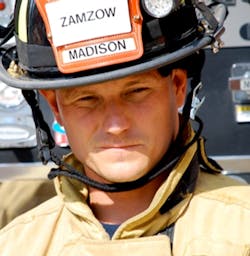Health & Wellness: Exercise to Defeat Stress, Anxiety & Depression
Resiliency can be considered the ability of an individual to bounce back from traumatic events and to deal with stresses in healthy ways. A resilient first responder uses effective coping strategies to adapt well in the face of adversity, trauma, tragedy, threats or significant sources of stress.
A major trauma event or near-death experience can impair resilience, even for experienced responders. This can result in feelings of grief, sadness or other emotions. Resilient individuals can work through the emotions and effects of stress and painful events and rebuild and maintain a healthy lifestyle.
Exercise isn’t just about improving aerobic capacity and muscle size. Even modest amounts of exercise, no matter your age or fitness level, can help to provide a sense of well-being. It can help you to sleep better at night and improve memory, self-worth and confidence. It can have a profoundly positive effect on depression, anxiety and post-traumatic stress disorder (PTSD).
Exercise reduces stress
Under stress, your body can be tense, particularly in the face, neck and shoulders. Stress potentially can lead to back and neck pain and a painful headache. Stress also can lead to a tightness in your chest, a pounding pulse and muscle cramps. You also might experience insomnia, heartburn, stomachache or diarrhea. The worry and discomfort of all of these physical symptoms can, in turn, lead to even more stress, creating a vicious cycle between your mind and body. Exercise is an effective way to break this cycle. It releases endorphins in the brain, which helps to relax the muscles.
Depression, anxiety, PTSD
Studies show that exercise can treat mild to moderate depression as effectively as antidepressant medication—but without the side effects—for several reasons. Most importantly, it promotes healthy responses in the brain by reducing inflammation and creating activity patterns that promote feelings of calm and well-being. Exercise can serve as a distraction, allowing you to find quiet time to break out of the cycle of negative thoughts that feed depression.
Exercise is a natural and effective anti-anxiety treatment. It relieves tension and stress, boosts physical and mental energy and enhances well-being through endorphin-release.
There is evidence to suggest that exercise helps to reduce the symptoms of traumatic stress and PTSD in numerous ways. As you exercise, your heart rate, breathing rate and body awareness increase. (Body awareness relates to the sensory information that one receives from the movement and force of muscles and joint groups.) Body awareness can help the nervous system to immobilize the negative responses of PTSD or trauma. Research shows that exercises that involve full-body movement patterns, such as weight training, walking/running and swimming, are the best choices in this case.
How much to benefit?
You don’t need to devote hours out of your day to train at the gym, lift weights, and do sprints and burpees. You can reap the mental health benefits of exercise with 30 minutes of moderate exercise five times per week. (You can break the sessions up into two or three sessions per day.
What is moderate exercise? It’s a movement that gets you to breathe a little heavier than normal but doesn’t cause you to be out of breath. For example, you should be able to chat with your walking partner but not easily hold a long conversation. You should break a sweat but not overheat or be drenched in perspiration.
Even just a few minutes of physical activity are better than none. You can start with 5-minute sessions and slowly increase your time as you progress.
No excuses
Exercise obstacles are very real, particularly when you are struggling mentally.
Too tired. When tired and/or stressed, you can feel as if working out makes things worse: The thought of adding another obligation can seem overwhelming given your schedule and your energy level.
The truth is, physical activity is a powerful energizer. Studies show that regular exercise can reduce fatigue dramatically and increase energy levels. If you feel very tired, make a promise to do just a 5-minute walk. Chances are, it will turn into something longer.
Also, schedule your workout at the time of day when your energy is highest. Typically, this is first thing in the morning. The workout will help you to stay energized throughout the day and provide a sense of accomplishment.
Where to start? A ton of resources can help you to get started on your fitness journey. That said, sometimes, the vast amount of information can be overwhelming and produce analysis paralysis. No matter your weight, age or fitness level, there are others like you who have the same goal of getting fit. Try to surround yourself with people who are in your shoes. Take an online class or find a local gym that provides training. Talk to your crew or reach out to a member of your department for help. (You even can reach out to me for programming and exercise options; see how to contact me on the previous page.)
Even if you are starting from square one, you still can work out. Start with basic movements and work on adding strength and stamina. If you have no experience exercising, begin slowly. Work on improving mobility with low-impact movement.
Lack motivation. We all experience some lack of motivation periodically, particularly if we feel depressed, anxious or stressed. Your mental state can rob you of the energy and motivation that you need to work out, or your social anxiety can make it so you can’t bear the thought of being seen running through the park.
Instead of committing to a complete workout, just decide to do some activity for 5 minutes. The basic idea is that procrastinators (which we all can be) often put off doing certain things, because the size of the task seems too overwhelming. Instead of thinking about the entire workout, just think about doing some light stretching and see where it goes from there.
There are other options for motivation. Download an app to remind you to work out or to help you to track your workouts. Download motivational music. Watch your favorite shows during your workouts. Join a fitness challenge. Recruit members of your crew to do group workouts.
Physical exercise is a powerful way to keep the brain—as well as the body—functioning at an optimum level. This gives you the best chance to think clearly, make accurate assessments, and execute good decisions during a crisis and after.
Resilient Responders
The U.S. Department of Health and Human Services defines resilience as a person’s ability to withstand, adapt to, and recover from adversity and stress. Exercise can help first responders to be resilient and, thus, to be better able to:
- Provide compassion to those who they serve
- Reach out for help and access needed resources more efficiently and effectively
- Miss fewer days of work
- Work through the strong emotions that come from being a responder in healthy ways (not relying on unhealthy coping mechanisms, such as drugs and alcohol)
- Have greater job satisfaction and career longevity

Aaron Zamzow
Aaron Zamzow is a firefighter/training officer for Madison, WI, Fire Department. He holds a bachelor’s degree in health/wellness and has 20 years of experience as a fitness trainer. He created Fire Rescue Fitness and authors programs that are aimed at getting fire rescue athletes fit for duty.






